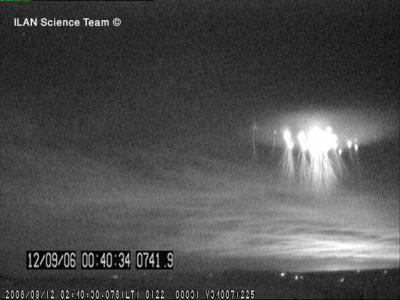 Диаметр структуры спрайтов может достигать 70 километров. Фото ILAN Science Team Диаметр структуры спрайтов может достигать 70 километров. Фото ILAN Science Team
The appearance of a "sprite" (about 30 miles high by 30 miles
wide), flashing above a distant thunderstorm. The "sprite" is about
175-250 miles away from the camera. (Credit: ILAN Science Team)
Появление НЛО объяснили спрайтами
Израильские ученые подробно описали редкий вид грозовых разрядов,
которые получили название спрайтов. В пресс-релизе Университета
Тель-Авива исследователи отмечают, что появление спрайтов может
объяснить некоторые случаи наблюдения НЛО.
Спрайты сопровождают почти любую грозу, однако их очень трудно
заметить. Эти разряды появляются на высоте от 55 до 130 километров. Для
сравнения, "обычные" молнии образуются на высоте не более 16
километров. Спрайты были впервые зафиксированы в 1989 году, причем это
произошло случайно. Астрономы, калибровавшие камеру для наблюдения
звезд, навели ее на верхние слои атмосферы, где неожиданно "засекли"
странные вспышки. На сегодняшний день о физической природе спрайтов
известно крайне мало.
Авторы данной работы изучали так называемые зимние спрайты
(появляются в зимние месяцы в северном полушарии) при помощи
дистанционно управляемых камер, установленных на крыше. Такой способ
позволил ученым наблюдать грозы, "производящие" спрайты, когда они еще
находились над Средиземным морем (сами приборы находились на территории
Израиля).
Спрайты чаще всего появляются не по одному, а группами. Ученые
показали, что необычные разряды чаще всего организуются по кругу. По
образному сравнению авторов работы, спрайты над грозой напоминают свечи
на пироге диаметром до 70 километров.
Спрайты не висят в небе неподвижно, а совершают "танцующие" движения.
По мнению исследователей, люди, утверждающие, что видели НЛО, могли
принять за летающую тарелку систему спрайтов.
Ссылки по теме
- Sprightly Explanation For UFO Sightings? - пресс-релиз Университета Тель-Авива, 24.02.2009
ScienceDaily (Feb. 24, 2009) — In legend,
sprites are trolls, elves and other spirits that dance high above our
ozone layer. But scientists at Tel Aviv University have discovered that
some very real "sprites" are zipping across the atmosphere as well,
providing a possible explanation for those other legendary denizens of
the skies, UFOs.
Thunderstorms, says Prof. Colin Price, head of the Geophysics and
Planetary Sciences Department at Tel Aviv University, are the catalyst
for a newly discovered natural phenomenon he calls "sprites." He and
his colleagues are one of the leading teams in the world studying the
phenomenon, and Prof. Price leads the study of "winter sprites" ― those
that appear only in the northern hemisphere's winter months.
"Sprites appear above most thunderstorms," explains Prof. Price,
"but we didn't see them until recently. They are high in the sky and
last for only a fraction of a second." While there is much debate over
the cause or function of these mysterious flashes in the sky, they may,
Prof. Price says, explain some bizarre reports of UFO sightings.
An Electrifying Discovery
Sprites are described as flashes high in the atmosphere, between 35
and 80 miles from the ground, much higher than the 7 to 10 miles where
regular lightning bolts usually occur.
"Lightning from the thunderstorm excites the electric field above,
producing a flash of light called a sprite," explains Prof. Price. "We
now understand that only a specific type of lightning is the trigger
that initiates sprites aloft."
Though sprites have existed for millions of years, they were first
discovered and documented only by accident in 1989 when a researcher
studying stars was calibrating a camera pointed at the distant
atmosphere where sprites occur.
"Sprites, which only occur in conjunction with thunderstorms, never
occur on their own, and are cousins to similar natural phenomenon
dubbed by atmospheric electricians as 'elves,' 'goblins' and 'trolls,'"
Prof. Price says. These flashes are so named because they appear to
"dance" in the sky, which may explain some UFO sightings.
Candles on a Celestial Birthday Cake
Tel Aviv University's research team is one of the leading global
groups studying the phenomenon. But Prof. Price and his students are
now working in collaboration with other Israeli scientists from The
Open University and The Hebrew University to take three-dimensional
pictures of sprites to gain a better understanding of their structure.
Using remote-controlled roof-mounted cameras, the researchers are able
to look at the thunderstorms that produce sprites when they are still
over the Mediterranean Sea.
From their unique vantage point in Israel, the researchers are
leading the world in the study of winter sprites. Prof. Price's new
camera techniques, in particular, have revealed the sprites' circular
structures, which are much like those of candles on a birthday cake.
Using triangulation, Prof. Price and his team have also been able to
calculate the dimensions of the sprites' features. "The candles in the
sprites are up to 15 miles high, with the cluster of candles 45 miles
wide –– it looks like a huge birthday celebration!"
Because of their high altitude, sprites may also have an impact on
the chemistry of the Earth's ozone layer. "Since they are relatively
infrequent, the global impact is likely small," says Prof. Price. "But
we're researching that now."
|

